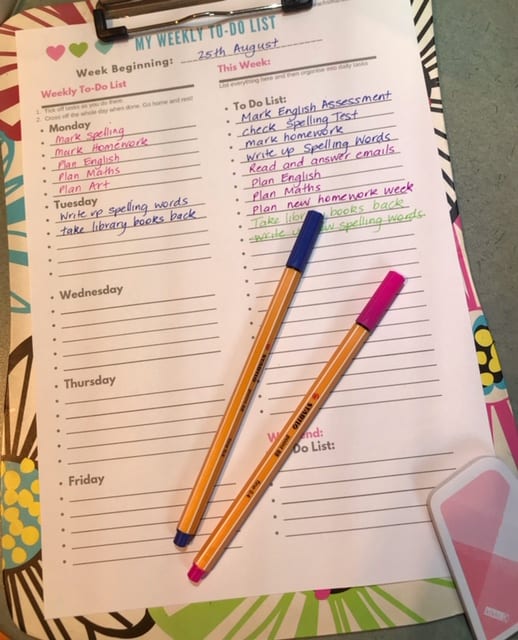Inside: Read the routine I use to help you save time planning your teaching week. These are quick and easy steps that will get home sooner!

Do you need a quick planning routine that will set you up for the rest of the school week?
If you’ve read any of my other posts you’ll know that I’ve been on a mission over the last few years to work much smarter as a teacher.
To do this, I’ve been sourcing some ideas to help save myself time.
I’ve found that setting up regular routines and systems in your week is how you can save a lot of time as a teacher, and here I’ll describe this routine that I use to save time planning your teaching week too.
These steps are basic but can be very useful if followed routinely.
An easy 30-minute weekly setup
Early in my teaching career, I used Sunday afternoons for my big planning session for the week.
But as the years have gone on, I am pleased to say that I have become more organised, so now I use a short time on a Friday afternoon after school to set up my week.
Whatever day suits you best, it will only take you 30 minutes to use my suggestions to get organised for your new teaching week!
Update: I now use my non-contact time on a Thursday to get all of this in place before the end of the week and this has made a huge difference for me.
**You choose what’s best for you.
These are the resources and steps I use to to get this routine going.
Useful resources needed for planning time:
- Have a teacher planner that shows: week to a view
- Get a printed copy of a monthly calendar with a month to a view, which will give you a better overall picture of the coming month
- In addition, have a printed copy of your whole school’s term planner (with all the relevant school dates added).
- NOTE: checkout the FREE time management printables from the Teacher Resource Library)
Once you have all of these resources together, this is where the MAGIC will happen to save yourself a HEAP of time.
6 steps to save time planning your teaching week
Step 1: Review your calendar
Firstly, you will need to quickly review your whole school term calendar and find the important dates that are relevant for your class and any whole-school event.
Then, document these dates for the whole term into your teacher planner. (This only really needs to be done once for the term, unless anything changes).
Now, take the most current of these events and transfer them onto your teaching planner and class timetable/schedule for the coming week.
**These key whole school events form the basis for your planning.
Knowing this information will help you to successfully plan your class timetable. It will also assist to identify how much time you have to teach the content.
NOTE: This step in your weekly planning is a CRUCIAL part for you to know the important whole school dates and not miss anything. For example when swimming starts, or when whole school assemblies/parades are or the dates for parent interviews and information nights etc etc – you get the picture.
Also, DON’T FORGET to leave some blank spaces in your schedule in case you need to add unexpected things or make catch-up time for students to complete unfinished work.
Sign up here to get FREE time-management resources to plan your week:
Check out the printables from the FREE Resource Library:
- blank to-do-lists
- blank monthly calendars
- teacher planners
- classroom management resources and even…
- self-care and wellbeing resources for teachers
Step 2: Identify the most important tasks for the week
This is where you’ll identify all of the MOST important projects and tasks that must be completed for the week and then write them onto your calendar and to-do list. (Check your deadlines to help you.) A SMARTER TEACHER TIP: only do one major task per week
Use this time to do a big BRAIN DUMP of all the tasks swirling around in your head out and onto paper, so they’re not forgotten. Use this To-do list system to help you here. The BIG benefit in doing this is, once they’re on your list you’ll be able to switch off your brain when you get home.

Get your FREE To-Do list system here:
Related Article: Tips for Teachers: How to Stop Thinking About School
Step 3: Schedule tasks into your week
Now’s your chance to consider each task’s importance and when they need to be completed by. This won’t take long, once you get started.
This is where the job of PRIORITIZING is so helpful. It allows you to consider deadlines and need, and then add them to the day they’re required to be completed by (Monday through Friday).
If you don’t have success with using a to-do list, check out this Easy 3-step to-do list system (A one-page printable with instructions) which will help you with this job. NOTE: If you need a little bit of extra help with organizing your list read How to Save Valuable Time in the Classroom: An Easy 3-Step System, which will walk you through the process.
Larger projects can be broken into smaller, more easy-to-tackle jobs and then scheduled into your week as well. IMPORTANT: – Learning to juggle your week by adding these extra tasks to a day that has LESS to do will help bring balance to a busy week.
This SUPER EASY to-do list is quick to use and will help you manage your list and stop the overwhelm with a long to-do list. I know that since I started using this to-do list, it’s been a game-changer with improving my productivity and stress levels.
Related Article: 7 Easy Tips to Increase Teacher Productivity
At this point, you can now plan when you’re teaching each subject area and allow the allotted teaching time for all curriculum areas. (use your standard weekly timetable here).
Step 4: Check emails
Next, quickly check emails. I know that often we do this without thinking. But a smarter tip is to become more intentional about WHEN you do this throughout the day.
I suggest to ONLY check your emails 3 x per day (morning, lunchtime, and at the end of the workday). This will help you save A HEAP OF TIME randomly scrolling through your emails at any time of the day.
Bonus time-saving tip for teachers:
Whenever possible, check your emails on your COMPUTER, not your phone. THIS IS KEY! You’ll find that if you check your emails on your phone, you will read, but don’t respond to them – THIS IS A HUGE TIME-WASTER and is to be avoided at all costs to stop double handling and stop emails getting lost in your inbox too.
Later, once you’re at your computer, respond to the email IMMEDIATELY after reading it, where this is logistically possible.
If you can’t respond to an email right way, flag the email so that it doesn’t get lost or overlooked.
Also, remember to delete emails or archive every one after you have dealt with it.
NOTE: Don’t forget to delete or unsubscribe from any discussion forums or newsletters that you are no longer interested in. This will stop the huge pile of email clutter in your account and ultimately stop the overwhelm.
Step 5: Review schedule
Now each afternoon or evening, quickly review your schedule/timetable so that you know what is coming up for the next day. This will take no time at all because everything is done and planned for.
With a quick review of your plan, you will feel much more ‘with-it’ and on top of the upcoming day and all that entails. (Don’t leave this job for the next morning. Because if you’re like me, your mind will dwell on the unknown and it may impact your sleep.
Step 6: Get together all teaching resources
Now that you know the lessons you are teaching for the week, you can prepare all the resources in advance. This will include:
- Lesson plans for each subject area. Re-use these from year to year to save time (remember to file these away at the end of the day into specified subject folders)
- photocopying of the lesson activities
- collection of manipulatives, books or hands-on materials etc for each lesson
One last word to save time planning your teaching week…
All of these steps are very simple, but the essential trick to save time planning your teaching week, is to remember it’s the ROUTINE and SYSTEM you get yourself into that will ultimately save the time.
By following a regular routine to plan your teaching week you will begin an EASY TO FOLLOW habit. When habits are formed and are in place, that’s when you’ll become faster and save a whole heap more time.
You’ll end up becoming a genius with time management and your week will be planned in no time at all! 🙂
End product?
You’ll create more downtime and balance in your life, which is the goal for many teachers.
Remember you are worth it!
Michelle x
RELATED ARTICLES:
- How to Save Valuable Time in the Classroom: An Easy 3-Step System
- 5 Top Tips to be More Organised Next Term
- How to Work Smarter Not Harder as a Teacher
- Tips for Teachers: How to Stop Thinking About School
- How to Thrive as a Teacher Throughout the Whole School Year
Want to remember this? Pin this to your favourite Pinterest board!





Leave a Reply